How Does Extraversion Influence Men’s Sexual Success?
A question which has long been the subject of debate on the internet is “what guys get laid the most?”. Answers have ranged from guys with confidence and game, to guys with wealth and social status, to guys who are simply more physically attractive.
Much to consternation of the black piller however, it has been firmly established that physical attractiveness and height have very limited predictive power in this domain. Where else should we look? Could those old pickup artists who promoted the importance of rizz and confidence have been onto something after all? Of the ‘Big Five’ personality traits, the most pertinent to this question would likely be extraversion. It is comprised of six facets: gregariousness, assertiveness, excitement seeking, activity, warmth, and positive emotions.
The link between extraversion and sexual behaviour had been documented as early as the 60s by German researchers who studied a large sample of about 6,000 students. Among men in the bottom 20% of extraversion, 47% had had sex, compared to 77% in the top 20% of extraversion. By age 17, 5% of introverts and 21% of extraverts had had sex. By 19, 15% and 45% had done so. Among the sexually active, the median frequency of coitus per month was 3 and 5.5 respectively. Among the unmarried, 18% of introverts and 30% of extraverts had 2-3 coitus partners in the past year, 7% of introverts and 25% of extraverts had had 4 or more. 10% of introverts had experienced more than 3 different coital positions compared to 26% of extraverts (Giese & Schmidt, 1968).
Eysenck (1972) and Curran et al. (1973) similarly found that extraverted men had significantly higher chances of having experienced a variety of sexual behaviours.
Schenk et al. (1986) asked the following questions to a sample of 498 German army recruits, ‘How old were you when you had sexual intercourse for the first time?’, ‘With how many partners have you had sexual intercourse?’, and ‘How often have you had sexual intercourse during the last 6 months?’. They also filled out a battery of questionnaires including a short version of Eysenck’s MPI measuring extraversion and neuroticism. Extraversion correlated with all 3 items in the expected direction at .35-.36.
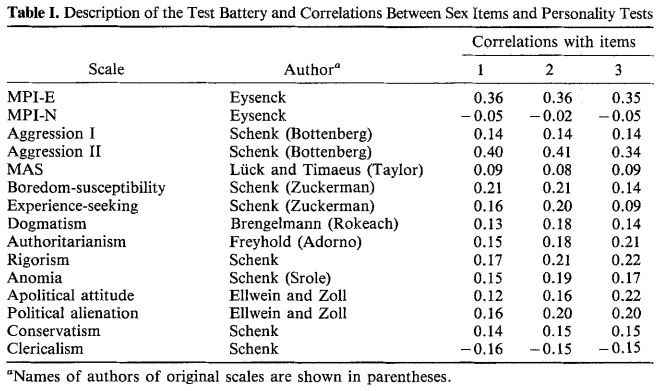
In Nettle (2005), extraversion predicted lifetime sexual partner number with an η2 value of .09, meaning 9% of the overall variance in lifetime sexual partners was accounted for by it. It may sound small, but to illustrate the effect, the proportion of participants who had 10 or more sexual partners was 16.2% in the lowest quartile of extraversion and 43.8% in the highest.
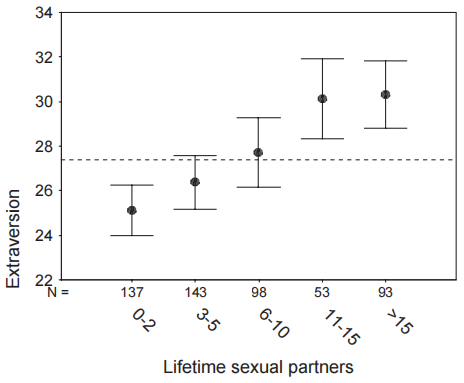
It was also associated with infidelity (but only significantly so in men). 63.9% of men in the top quartile had had an extra-pair copulation compared to 30.6% in the bottom.
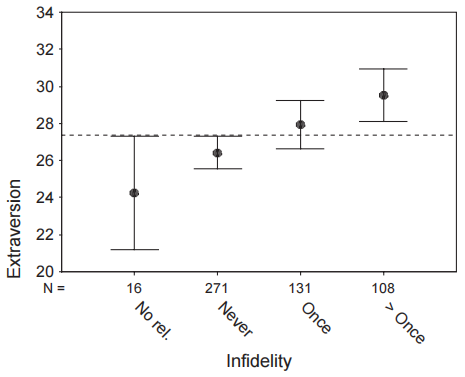
This scatterplot I made using the raw data from study 2 of von Borell et al. (2019). Sociosexual behaviour refers to the total number of sex partners they’ve had in the past year, that they’ve had one-night stands with, and that they’ve had without any intention of forming a committed relationship. It’s a pretty straightforward relationship: the more extraverted, the more sex partners (on average).
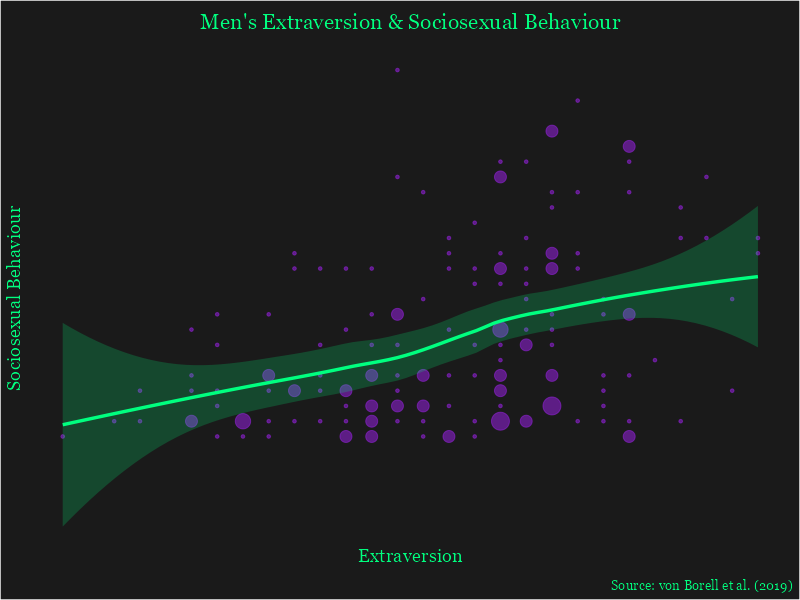
This is how facial attractiveness and height look on the other hand. A very slight positive correlation overall but it’s not nearly as immediately apparent (and failed to reach statistical significance despite a decent 163 sample size).
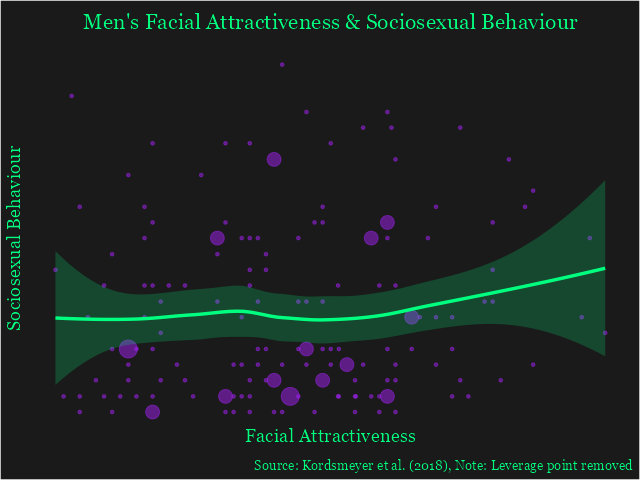
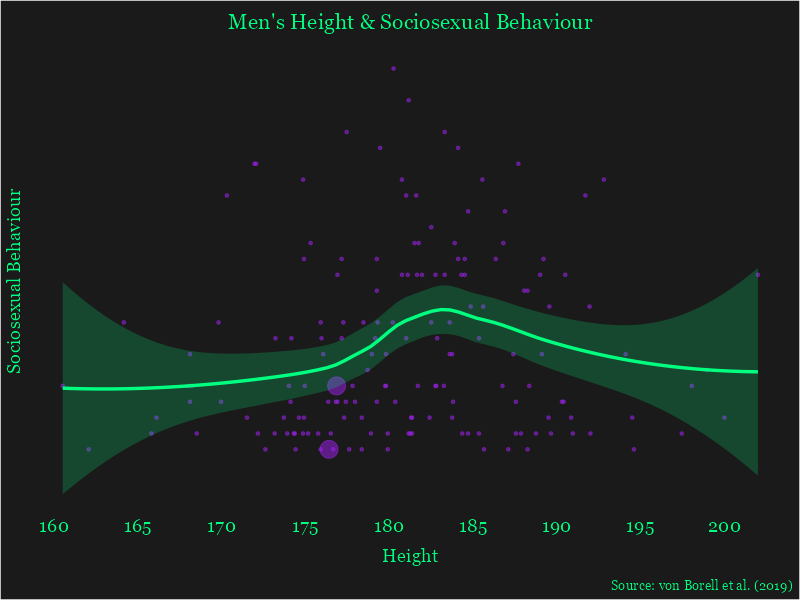
Meta-analysis
Now for the moment of truth. What kind of effect size does a meta-analysis of all the studies (that I could find) yield? Does it really have more of an impact than physical traits?
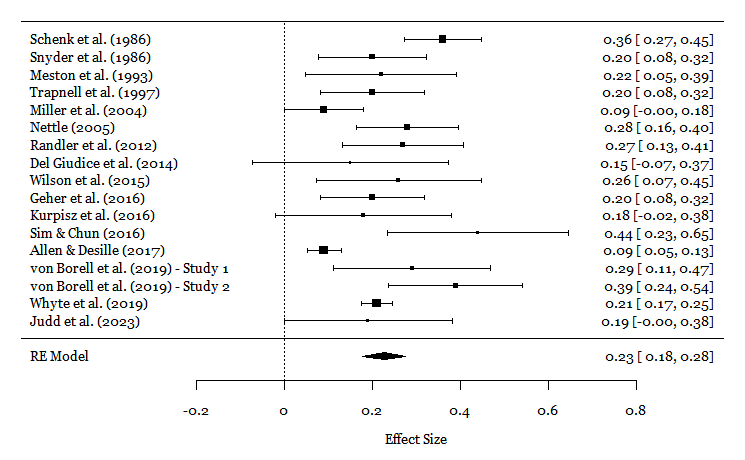
.23, not too bad. You might say this is a weak correlation, and you’d be right, but comparing this estimate to the ones observed in the cases of facial attractiveness and height, it still explains more variance than them combined. We’re at least more firmly in ‘weak’ territory.
Some studies were excluded as they didn’t provide separate effect sizes for men and women. Including them doesn’t seem to affect the outcome though, so there likely isn’t a big gender difference here (although in some cases there was, e.g. Rogowska et al. (2022) found a significantly larger effect for men).

There was evidence for heterogeneity between studies, but no funnel plot asymmetry which would indicate publication bias. Maybe it’s due to inter-sample diversity. In the 2017 study with the .09 effect size for example, the mean age was 65.6, although the earliest studies were done when they would’ve been young and they didn’t show such low correlations so who knows.
Causal Pathways
It is now time to proceed to the explanatory phase. What is the underlying reason behind this relationship?
The first thing that will come to mind for the black piller will naturally be physical attractiveness. According to the black pill worldview, personality is simply a product of lookism. Attractive people are loved by everyone and treated like royalty, leading to the development of a ‘good personality’, and vice versa. However, I’ve shown that the relationship between extraversion and physical attractiveness is very weak (and not necessarily the result of lookism either but possibly self-enhancement motivation).
Turning back to the von Borell et al. (2019) dataset, running a partial correlation controlling for facial attractiveness and height had virtually no effect. There was also no evidence for a moderation effect whereby extraversion boosted more attractive or tall men’s sociosexual experience more, which isn’t too surprising given their weak correlations. While this sample may be underpowered to detect small mediation or moderation effects, they don’t seem likely to play a large role. Extraversion seems to ‘work’ just as well even for the unattractive and short.
There tends to be an underlying assumption that the men who have the most sex must be the most desired by women, but is this always the case? Sex doesn’t happen in a vacuum. It is a social activity that in turn tends to rely on socialization. Therefore we shouldn’t be surprised if a guy who is more attractive but stays in his room all day watching anime is outdone by one who is less attractive but puts himself out there and is always chatting up girls. Extraverts develop wider social networks (Feiler & Kleinbaum, 2015) which wouldn’t hurt as a significant number of people meet partners through friends. Extraversion is also correlated with alcohol consumption (Martsh & Miller, 1997) which is associated with sexual activity (Graves & Leigh, 1995).
Nonetheless, it may also be the case that extraverts are indeed considered to be more desirable. Sadalla et al. (1987) found that behavioural dominance, roughly corresponding to the assertiveness facet of extraversion, increased men’s sexual attractiveness to women.
Berry & Miller (2001) paired people up in opposite-sex dyads to have a 6 minute interaction which was videotaped. The interactions were rated in quality by the pair and independent observers. For men, out of the Big Five traits and observer-rated attractiveness, only extraversion significantly predicted interaction quality as rated by themselves, their partners, and independent observers.
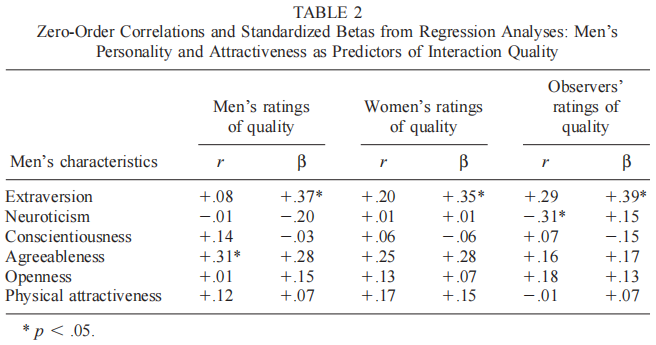
Van der Linden et al. (2010) found that among adolescent classmates, extraverts were rated as more likeable and popular, with extraversion dwarfing the other Big Five traits, and extraverts are rated as more likeable and higher in status even in thin-slice judgments (Stopfer et al., 2013). Extraversion has also been shown to positively affect desirability in a speed-dating setting (Humberg et al., 2023), and Wu et al. (2016) found that while a gene linked to social submissiveness decreased men’s desirability in a speed-dating experiment, one linked to social dominance increased it.
Another factor may be its association with social status. Nettle (2005) found that extraversion correlated with traits relating to status acquisition such as ambition and competitiveness.
Anderson et al. (2001) found that social status, defined here by peer ratings of prominence and the number of positions and offices each member had held in the house, correlated with extraversion in a sample of fraternity members. As we see this association barely changed after controlling for attractiveness as it wasn’t significantly associated with extraversion.
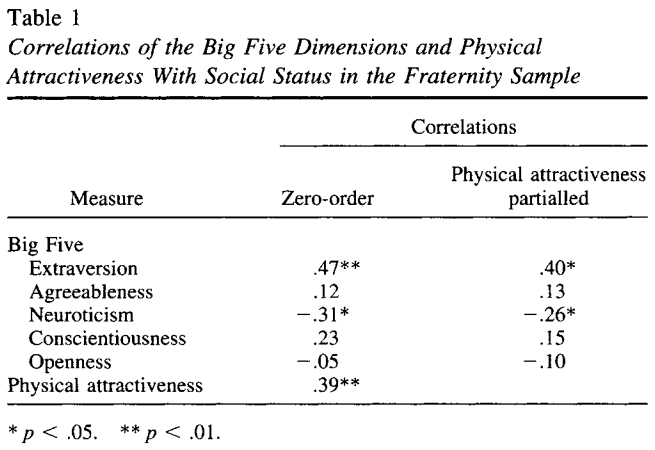
Anderson et al. (2012) found that it was associated with a higher sense of power and sociometric status. Extraversion and related traits like sociability and dominance are qualities conducive to leadership (Judge et al., 2002). To the extent that women are drawn to men who are higher on the ‘social hierarchy’ then this will be another factor working in extraverted men’s favour.
Finally, extraversion may facilitate a fast life history strategy, which prioritizes short term reproductive gains at the expense of parental investment, i.e. quantity over quality. In this case we’d expect it to be associated with sociosexuality, which describes a person’s orientation toward uncommitted sex. Some have argued that it actually promotes a slow life history strategy, and others have suggested that it includes components of both, with facets like warmth and gregariousness aligning with a slow and excitement seeking and assertiveness a fast strategy (Manson, 2017).
Nettle (2005) found that extraversion correlated at .21 with interest in sex, but not the number of sex partners desired in the next 2 years. Turchik et al. (2010) found that for men, extraversion correlated at .31 with sexual risk taking and non-significantly at .2 with sensation seeking (though the .21 correlation for women was significant). Schmitt & Shackelford (2008) surveyed 13,243 people from across 46 nations. For men the correlation between extraversion and short-term mating interests was .09, unrestricted sociosexual orientation .16, mate poaching attempts .15, succumbing to poaching .07, and lack of relationship exclusivity .1. Whyte et al. (2019) found among 2,998 Australian male survey takers an association between extraversion and sociosexual attitude of .08 and desire of .09. So there’s definitely something there, but only enough to mediate at most a small portion of the association.
We can also test this in the von Borell (2019) dataset. Controlling for sociosexual desire and attitude had virtually no effect on the association between extraversion and sociosexual behaviour in study 2. In study 1, controlling for sociosexual desire had virtually no effect. Controlling for sociosexual attitude lowered the correlation from .294 to .197, but it remained significant.
We can also at least in study 1 test how the particular facets correlate with sociosexual behavior. Warmth correlated at .16, gregariousness at .3, assertiveness at .21, activity at .2, excitement seeking at .31, and positive emotions at .16. Warmth and positive emotions were no longer significant, but the differences wouldn’t be either. Sim & Chun (2016) found a .44 correlation between assertiveness and lifetime sex partners. From this we can deduce that it’s more related to being outgoing, dominant, and stimulus hungry than being friendly or joyful, though of course it’s nothing conclusive.
Conclusion
We have successfully identified a trait which more effectively predicts sexual partner count than facial attractiveness and height, which albeit wasn’t a high bar to clear.
Of course there’s always the question of how much we should value the metric of ‘body count’. Even in men it doesn’t seem to be associated with superior mental health (no citation on me atm). There’s probably no one approach which suits or satisfies everyone equally though. I imagine it could be frustrating to be intrinsically short-term mating oriented but unable to effectuate it due to low extraversion for instance. Given that at least prior to the advent of contraception it would’ve tended to increase offspring number it’s by no means an irrelevant metric, but at the same time if none of them survive to adulthood then investing in one would’ve been a better idea.
There are also both costs and benefits to being bold, it can be rewarding but can also get you in hot water. Another finding of Nettle (2005) is that participants who’d been hospitalized due to illness or accidents were significantly higher in extraversion. Similarly, Fauerbach et al. (2000) found that burn survivors were significantly higher in extraversion. People with larger social networks also contract more illnesses (Christakis & Fowler, 2010). This helps explain why everyone isn’t hyper-extraverted despite obvious advantages.
Something else to consider is that this research says nothing about partner quality. Extraverts may be lowering their standards, especially if they’re intentionally going for hook-ups as men are more flexible in this context. The partners of extraverted unattractive men may also be less attractive on average than the partners of attractive less extraverted men.
Does it also mean that extraversion is more attractive than physical attractiveness? To be honest I’m not sure I’d go that far. The reason why the correlation trumps that of physical attractiveness and height is probably that it’s not just about what you have but also what you do with it.
It’s also important to remember that this is just one personality trait. It’s unlikely to exhaust the variance relating to personality traits, though to be fair facial attractiveness and height might not for physical traits either. While it probably explains more variance than the rest of the Big Five, the Big Five is unlikely to encompass all individual differences in personality. For instance, the Autism-Spectrum Quotient doesn’t appear to be fully or even mostly accounted for by the five factor model (Wakabayashi et al., 2006). Then we can’t forget about the Dark Triad, which may actually be a stronger predictor than extraversion. It’s also possible that a more nuanced facet level approach could have more predictive power than a broader factor level approach.
Should you go and sign up for a PUA bootcamp to ‘learn’ to be more alpha and socially adept then? As I said in ‘Is Confidence Linked To Attractiveness?‘, there is going to be a genetic element (and early developmental factors) which will be difficult to overcome. People can generally smell when you’re pretending to be something you’re not as well. I’m not sure exactly how much wiggle room there is or what the most efficient extraversionmaxxing procedures are. CBT? Cocaine? What we can say with confidence though is that the reason ‘just be confident’ is not useful advice is not because confidence itself doesn’t work.
References
Alexander (2023). Male Attractiveness and Sexual Partner Count. Date Psychology. https://datepsychology.com/male-attractiveness-and-sexual-partner-count/
Giese H., & Schmidt G. (1968). Studenten-Sexualität. Rowholt, Hamburg.
Eysenck, H. J. (1972). Personality and sexual behaviour. Journal of Psychosomatic Research, 16(3), 141–152. https://doi.org/10.1016/0022-3999(72)90037-2
Curran, J. P., Neff, S., & Lippold, S. (1973). Correlates of sexual experience among university students. Journal of sex research, 9(2), 124–131. https://doi.org/10.1080/00224497309550787
Schenck, C. H., Bundlie, S. R., Ettinger, M. G., & Mahowald, M. W. (1986). Chronic behavioral disorders of human REM sleep: a new category of parasomnia. Sleep, 9(2), 293–308. https://doi.org/10.1093/sleep/9.2.293
Nettle, D. (2005). An evolutionary approach to the extraversion continuum. Evolution and Human Behavior, 26(4), 363–373. https://doi.org/10.1016/j.evolhumbehav.2004.12.004
von Borell, C. J., Kordsmeyer, T. L., Gerlach, T. M., & Penke, L. (2019). An integrative study of facultative personality calibration. Evolution and Human Behavior, 40(2), 235–248. https://doi.org/10.1016/j.evolhumbehav.2019.01.002
Snyder, M., Simpson, J. A., & Gangestad, S. (1986). Personality and sexual relations. Journal of Personality and Social Psychology, 51(1), 181–190. https://doi.org/10.1037/0022-3514.51.1.181
Meston, C. M., Trapnell, P. D., & Gorzalka, B. B. (1993). Sex and the five factor model of personality. Paper presented in The Annual meeting of the International Academy of Sex Research, Pacific Grove, CA
Trapnell, P. D., Meston, C. M., & Gorzalka, B. B. (1997). Spectatoring and the Relationship between Body Image and Sexual Experience: Self-Focus or Self-Valence? The Journal of Sex Research, 34(3), 267–278. http://www.jstor.org/stable/3813386
Miller, J. D., Lynam, D., Zimmerman, R. S., Logan, T. K., Leukefeld, C., & Clayton, R. (2004). The utility of the Five Factor Model in understanding risky sexual behavior. Personality and Individual Differences, 36(7), 1611–1626. https://doi.org/10.1016/j.paid.2003.06.009
Jonason, P. K., Li, N. P., Webster, G. D., & Schmitt, D. P. (2009). The dark triad: Facilitating a short-term mating strategy in men. European Journal of Personality, 23(1), 5–18. https://doi.org/10.1002/per.698
Raynor, D. A., & Levine, H. (2009). Associations between the five-factor model of personality and health behaviors among college students. Journal of American college health : J of ACH, 58(1), 73–81. https://doi.org/10.3200/JACH.58.1.73-82
Jonason, P.K., Cetrulo, J.F., & Ortiz, J. (2011). Avoiding the wash: Extraversion provides a net fitness gain. The Journal of Social, Evolutionary, and Cultural Psychology, 5, 146-154.
Randler, Christoph & Ebenhöh, Nadine & Fischer, Arian & Höchel, Sandra & Schroff, Christina & Stoll, Julia & Vollmer, Christian & Piffer, Davide. (2012). Eveningness is related to men’s mating success. Personality and Individual Differences. 53. 263-267. 10.1016/j.paid.2012.03.025.
Del Giudice, M. (2014). An evolutionary life history framework for psychopathology. Psychological Inquiry, 25(3-4), 261–300. https://doi.org/10.1080/1047840X.2014.884918
Wilson, M. C., Zilioli, S., Ponzi, D., Henry, A., Kubicki, K., Nickels, N., & Maestripieri, D. (2015). Cortisol reactivity to psychosocial stress mediates the relationship between extraversion and unrestricted sociosexuality. Personality and Individual Differences, 86, 427–431. https://doi.org/10.1016/j.paid.2015.07.003
Geher, Glenn & Kaufman, Scott & Garcia, Justin & Kaufman, James & Dawson, Blair. (2016). The validity and structure of mating intelligence. Evolution, Mind and Behaviour. 14. 1-22. 10.1556/2050.2016.0001.
Kurpisz, J., Mak, M., Lew-Starowicz, M., Nowosielski, K., Bieńkowski, P., Kowalczyk, R., Misiak, B., Frydecka, D., & Samochowiec, J. (2016). Personality traits, gender roles and sexual behaviours of young adult males. Annals of general psychiatry, 15, 28. https://doi.org/10.1186/s12991-016-0114-2
SIM, Kyungok & CHUN, Woo. (2016). The relationships of assertiveness and responsiveness to sexual behavior. PSYCHOLOGIA. 59. 50-69. 10.2117/psysoc.2016.50.
Allen, M. S., & Desille, A. E. (2017). Personality and sexuality in older adults. Psychology & health, 32(7), 843–859. https://doi.org/10.1080/08870446.2017.1307373
Arnocky, S., Piché, T., Albert, G., Ouellette, D., & Barclay, P. (2017). Altruism predicts mating success in humans. British journal of psychology (London, England : 1953), 108(2), 416–435. https://doi.org/10.1111/bjop.12208
Provenzano, Daniel & Dane, Andrew & Farrell, Ann & Marini, Zopito & Volk, Anthony. (2018). Do Bullies Have More Sex? The Role of Personality. Evolutionary Psychological Science. 4. 10.1007/s40806-017-0126-4.
Fernández Del Río, E., Ramos-Villagrasa, P. J., Castro, Á., & Barrada, J. R. (2019). Sociosexuality and Bright and Dark Personality: The Prediction of Behavior, Attitude, and Desire to Engage in Casual Sex. International journal of environmental research and public health, 16(15), 2731. https://doi.org/10.3390/ijerph16152731
Whyte, Stephen & Brooks, Robert & Chan, Ho Fai & Torgler, Benno. (2019). Do certain personality traits provide a mating market competitive advantage? Sex, offspring & the big 5. Personality and Individual Differences. 139. 158-169. 10.1016/j.paid.2018.11.019.
Aleksandra Rogowska, Magdalena Tofel, Barbara Zmaczyńska-Witek & Zofia Kardasz (2022) The relationship of number of sexual partners with personality traits, age, gender and sexual identification, Psychology & Sexuality, 13:2, 147-164, DOI: 10.1080/19419899.2020.1752786
Judd, L. J., Mills, J. G., & Allen, M. S. (2023). Altruism does not predict mating success in humans: A direct replication. Evolutionary Behavioral Sciences, 17(4), 465–471. https://doi.org/10.1037/ebs0000298
Feiler, D. C., & Kleinbaum, A. M. (2015). Popularity, similarity, and the network extraversion bias. Psychological Science, 26(5), 593–603. https://doi.org/10.1177/0956797615569580
Graves, K. L., & Leigh, B. C. (1995). The relationship of substance use to sexual activity among young adults in the United States. Family planning perspectives, 27(1), 18–33.
Sadalla, E. K., Kenrick, D. T., & Vershure, B. (1987). Dominance and heterosexual attraction. Journal of Personality and Social Psychology, 52(4), 730–738. https://doi.org/10.1037/0022-3514.52.4.730
Berry, Diane & Miller, Katherine. (2001). When Boy Meets Girl: Attractiveness and the Five-Factor Model in Opposite-Sex Interactions. Journal of Research in Personality. 35. 62-77. 10.1006/jrpe.2000.2304.
Van Der Linden, D., Scholte, R. H. J., Cillessen, A. H. N., Nijenhuis, J. T., & Segers, E. (2010). Classroom ratings of likeability and popularity are related to the Big Five and the general factor of personality. Journal of Research in Personality, 44(5), 669–672. https://doi.org/10.1016/j.jrp.2010.08.007
von der Heiden, Juliane & Egloff, Boris & Nestler, Steffen & Back, Mitja. (2013). Being popular in online social networks: How agentic, communal, and creativity traits relate to judgments of status and liking. Journal of Research in Personality. 47. 592-598. 10.1016/j.jrp.2013.05.005.
Humberg, S., Gerlach, T. M., Franke-Prasse, T., Geukes, K., & Back, M. D. (2023). Is (actual or perceptual) personality similarity associated with attraction in initial romantic encounters? A dyadic response surface analysis. Personality Science, 4. https://doi.org/10.5964/ps.7551
Wu, K., Chen, C., Moyzis, R. K., Greenberger, E., & Yu, Z. (2016). Gender Interacts with Opioid Receptor Polymorphism A118G and Serotonin Receptor Polymorphism -1438 A/G on Speed-Dating Success. Human nature (Hawthorne, N.Y.), 27(3), 244–260. https://doi.org/10.1007/s12110-016-9257-8
Buss, D. M. (1989). Sex differences in human mate preferences: Evolutionary hypotheses tested in 37 cultures. Behavioral and Brain Sciences, 12(1), 1–49. https://doi.org/10.1017/S0140525X00023992
Lenton, A. P., & Francesconi, M. (2010). How humans cognitively manage an abundance of mate options. Psychological science, 21(4), 528–533. https://doi.org/10.1177/0956797610364958
Li, N. P., Yong, J. C., Tov, W., Sng, O., Fletcher, G. J., Valentine, K. A., Jiang, Y. F., & Balliet, D. (2013). Mate preferences do predict attraction and choices in the early stages of mate selection. Journal of personality and social psychology, 105(5), 757–776. https://doi.org/10.1037/a0033777
Anderson, C., John, O. P., Keltner, D., & Kring, A. M. (2001). Who attains social status? Effects of personality and physical attractiveness in social groups. Journal of personality and social psychology, 81(1), 116–132. https://doi.org/10.1037//0022-3514.81.1.116
Anderson, C., John, O. P., & Keltner, D. (2012). The personal sense of power. Journal of personality, 80(2), 313–344. https://doi.org/10.1111/j.1467-6494.2011.00734.x
Manson, Joseph. (2017). Are Extraversion and Openness Indicators of a Slow Life History Strategy?. Evolution and Human Behavior. 10.1016/j.evolhumbehav.2017.01.005.
Turchik, J. A., Garske, J. P., Probst, D. R., & Irvin, C. R. (2010). Personality, sexuality, and substance use as predictors of sexual risk taking in college students. Journal of sex research, 47(5), 411–419. https://doi.org/10.1080/00224490903161621
Schmitt, D. P., & Shackelford, T. K. (2008). Big Five traits related to short-term mating: From personality to promiscuity across 46 nations. Evolutionary Psychology, 6(2), 246–282. https://doi.org/10.1177/147470490800600204
Fauerbach, J. A., Lawrence, J. W., Schmidt, C. W., Jr., Munster, A. M., & Costa, P. T., Jr. (2000). Personality predictors of injury-related posttraumatic stress disorder. Journal of Nervous and Mental Disease, 188(8), 510–517. https://doi.org/10.1097/00005053-200008000-00006
Christakis, N. A., & Fowler, J. H. (2010). Social network sensors for early detection of contagious outbreaks. PloS one, 5(9), e12948. https://doi.org/10.1371/journal.pone.0012948
Wakabayashi, Akio & Baron-Cohen, Simon & Wheelwright, Sally. (2006). Are autistic traits an independent personality dimension? A study of the Autism-Spectrum Quotient (AQ) and the NEO-PI-R. Personality and Individual Differences. 41. 873-883. 10.1016/j.paid.2006.04.003.

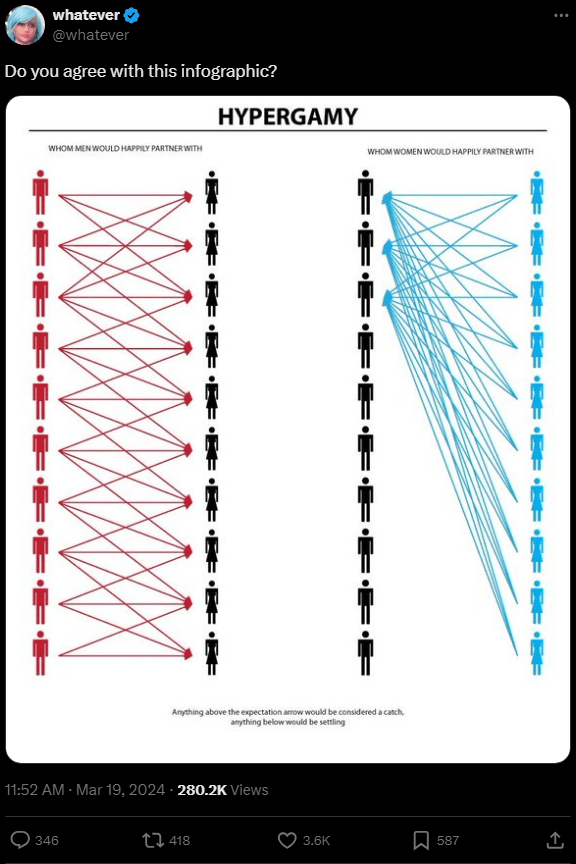
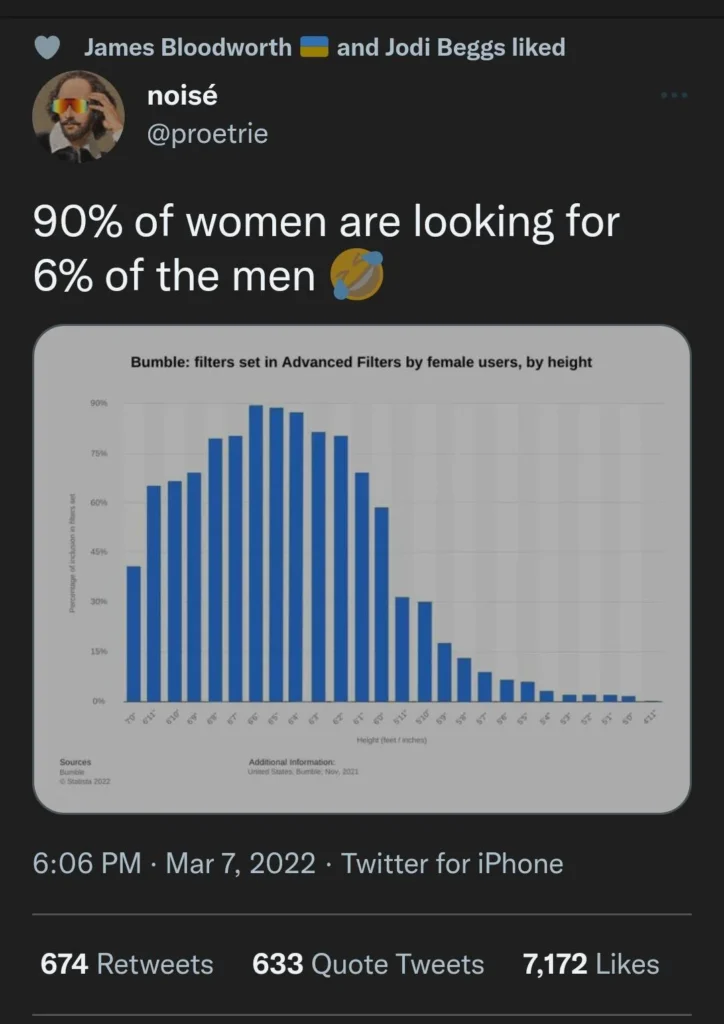
Heyo!
Another incredible article. I’ve been following all your content for a while, really appreciate what you’re sharing here.
So far it seems that you’ve focused mostly on the number of sexual partners, are you planning on exploring the important of physical attractiveness on partner quality? I.e do attractive people have better luck ending up with similarly attractive people, in short and long-term contexts? Maybe looking at the personality factors again too.
what i found interesting is that, regarding the first study from 1980’s germany, that the aggression-II test battery has an even higher correlation with the sex items than extroversion
Just wish to say your article is as surprising The clearness in your post is just cool and i could assume youre an expert on this subject Fine with your permission allow me to grab your RSS feed to keep updated with forthcoming post Thanks a million and please keep up the enjoyable work
Hello my loved one I want to say that this post is amazing great written and include almost all significant infos I would like to look extra posts like this
What i dont understood is in reality how youre now not really a lot more smartlyfavored than you might be now Youre very intelligent You understand therefore significantly in terms of this topic produced me personally believe it from a lot of numerous angles Its like women and men are not interested except it is one thing to accomplish with Woman gaga Your own stuffs outstanding Always care for it up
Wow superb blog layout How long have you been blogging for you make blogging look easy The overall look of your site is magnificent as well as the content
Thanks I have just been looking for information about this subject for a long time and yours is the best Ive discovered till now However what in regards to the bottom line Are you certain in regards to the supply
Wonderful web site Lots of useful info here Im sending it to a few friends ans additionally sharing in delicious And obviously thanks to your effort
I was recommended this website by my cousin I am not sure whether this post is written by him as nobody else know such detailed about my difficulty You are wonderful Thanks
Thank you for the auspicious writeup It in fact was a amusement account it Look advanced to more added agreeable from you By the way how could we communicate
Wonderful web site Lots of useful info here Im sending it to a few friends ans additionally sharing in delicious And obviously thanks to your effort
I do not even know how I ended up here but I thought this post was great I do not know who you are but certainly youre going to a famous blogger if you are not already Cheers
It is a pleasure to read this weblog, thanks to its up-to-date information and interesting posts. Look into my web page Webemail24 for some really good points and find out more about SEO.
Your blog is a true gem in the world of online content. I’m continually impressed by the depth of your research and the clarity of your writing. Thank you for sharing your wisdom with us.
certainly like your website but you need to take a look at the spelling on quite a few of your posts Many of them are rife with spelling problems and I find it very troublesome to inform the reality nevertheless I will definitely come back again